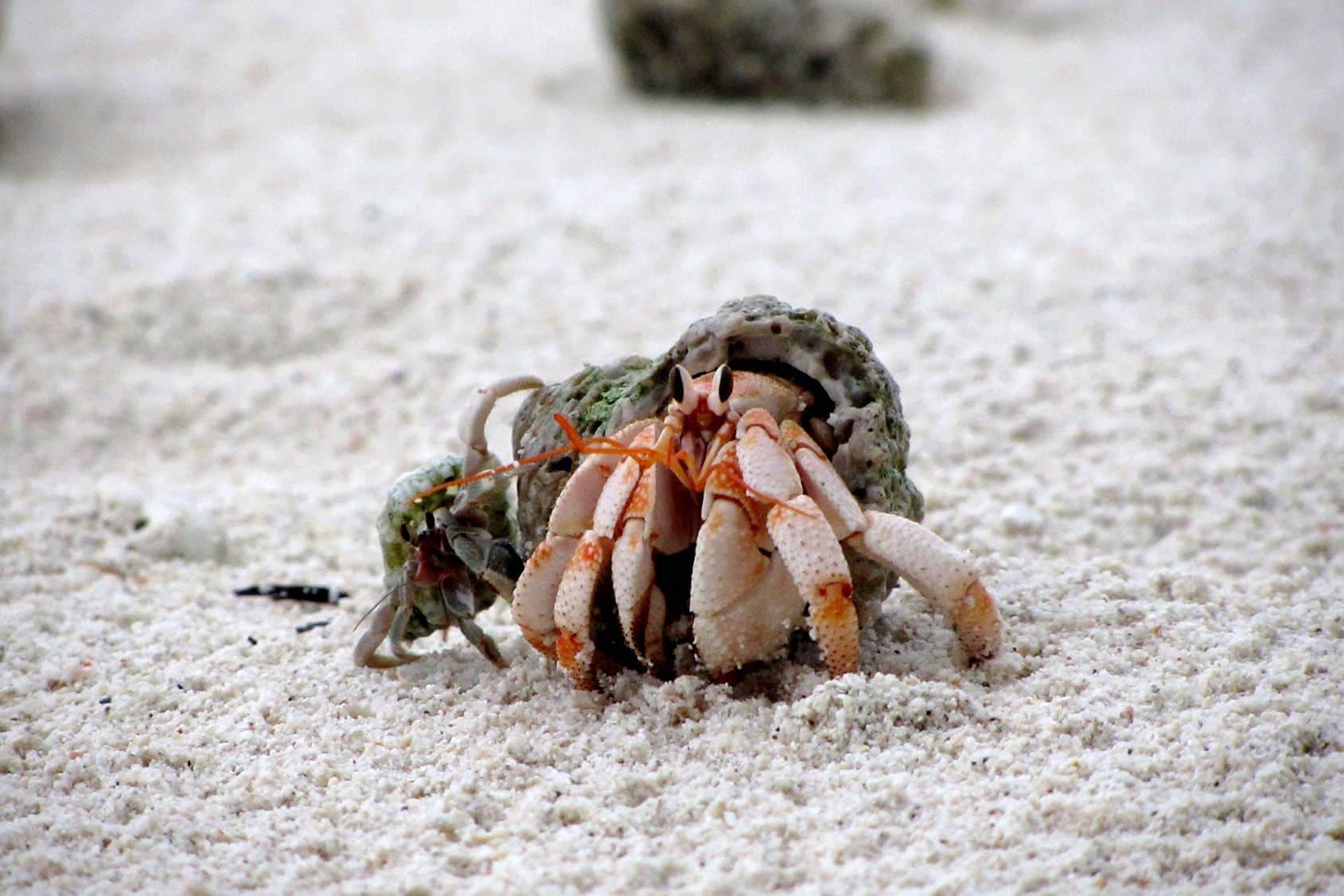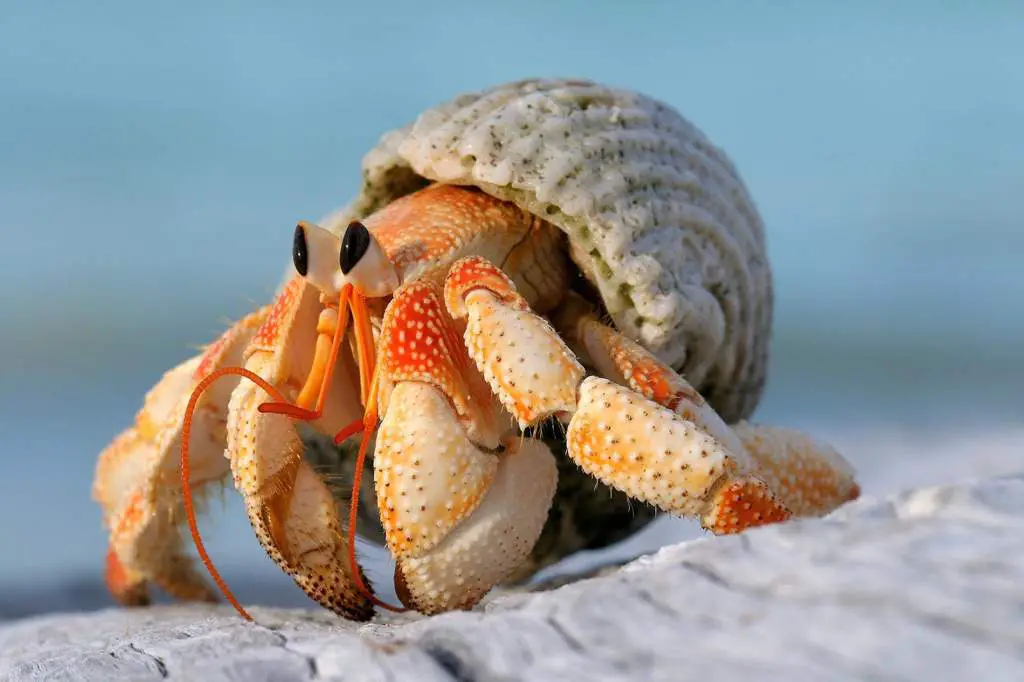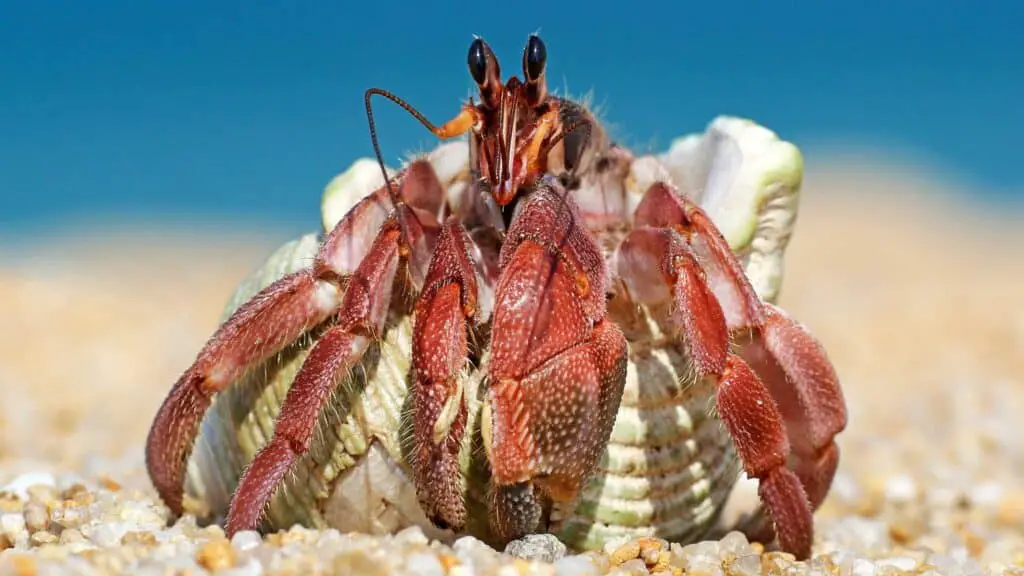Are Hermit Crabs Nocturnal

Introduction
Are Hermit Crabs Nocturnal: Hermit crabs, those peculiar and captivating crustaceans, have long intrigued both marine enthusiasts and curious minds. These small, shelled creatures are renowned for their unique lifestyle, where they occupy empty seashells as portable homes.
Understanding the activity patterns of these enigmatic creatures is not only a matter of scientific curiosity but also a crucial aspect of appreciating their natural behavior and biology. Nocturnal animals are those primarily active during the night, often under the cover of darkness, and this behavior can have significant implications for their survival, reproduction, and interactions with other species.
We embark on a journey to unravel the mystery of hermit crab activity patterns. We will delve into the fascinating world of hermit crabs, examining their behaviour, habitat, and the factors that influence their daily routines.
Join us as we delve deeper into the world of hermit crabs to shed light on their mysterious nocturnal tendencies or perhaps discover surprising aspects of their behavior that challenge conventional wisdom.

Are hermit crabs nocturnal?
Hermit crabs are nocturnal, which means they’re much more active at night than they are during the day.
While hermit crabs are often associated with nighttime activity due to their search for food and exploration under the cover of darkness, they do not adhere strictly to nocturnal patterns. These crustaceans are opportunistic, adapting their behavior to the circumstances at hand.
Hermit crab activity is influenced by various factors, including temperature, humidity, and predation risk. During the day, when temperatures are warmer and the risk of predation may be higher, some hermit crabs retreat into their shells and become less active. However, they can also be observed foraging for food and interacting with their surroundings during daylight hours.
Conversely, when the sun sets and the environment becomes cooler and less hazardous, hermit crabs often become more active, scavenging for food and exploring their habitats. This nighttime activity is a strategy that helps them avoid predators and maximize their chances of finding nourishment.
In essence, hermit crabs do exhibit nocturnal tendencies, but their behavior is adaptable and responsive to the conditions they encounter. To fully understand their activity patterns, one must consider the ever-changing interplay of environmental factors that influence these captivating creatures.
How far can a hermit crab walk at night?
1 mile each
Hermit crabs in the wild walk up to 1 mile each night, they are very social, and they can live 30 to 40 years in captivity.
The nocturnal adventures of a hermit crab can be quite remarkable, especially when it comes to their walking capabilities during the nighttime hours. While there is no fixed distance that all hermit crabs can walk at night, their journeys are largely influenced by their surroundings and objectives.
A hermit crab’s nightly stroll is often driven by its search for food, suitable shells, and interactions with other crabs. The distance they cover can vary widely, from just a few inches to several feet, depending on factors like the availability of resources and the level of competition from other crabs.
Their walking prowess is also influenced by the species and size of the crab. Smaller hermit crabs may travel shorter distances, while larger ones can cover more ground. Additionally, environmental conditions such as humidity and temperature can play a role in determining how far a hermit crab is willing to venture from its burrow or shelter.
Overall, the exact distance a hermit crab can walk at night is highly variable and context-dependent. These enigmatic creatures showcase their adaptability and resourcefulness as they navigate the darkness in search of sustenance and security, making them a subject of perpetual fascination for researchers and nature enthusiasts alike.
Where do hermit crabs live during the day?
During the hottest times of the day they’ll hide to avoid the heat, so look for them under flotsam and jetsam and sea shore plants. These are some of the sea snail shells that hermit crabs use for their homes.
During the daytime, hermit crabs retreat to the safety and shelter of their chosen homes, which are typically empty seashells or other protective enclosures. These portable shelters serve as a crucial part of their survival strategy.
Hermit crabs are vulnerable to desiccation and predation when exposed to the sun, so they seek refuge in their shells or burrows during the daylight hours. They tightly grip the shell’s interior with their abdomen and appendages, ensuring a secure fit. This shelter not only shields them from the harsh rays of the sun but also offers protection against potential predators like birds and larger crustaceans.
The choice of shells is vital for hermit crabs, as they need to find the right fit to accommodate their bodies as they grow. They often engage in “shell swapping,” where they find and occupy new shells when their current homes become too small. This process ensures they have a comfortable and protective shelter during both day and night.
In addition to seashells, some hermit crabs may also burrow into the sand or seek refuge among rocks and vegetation to avoid exposure during the day. These daytime hideaways provide them with a secure and relatively stable environment until the cover of darkness allows them to resume their nocturnal activities.
Can hermit crabs breathe without air?
Hermit crabs breathe through modified gills, which means they need humid air to breathe. Hermit crabs can’t breathe air and they will drown in water, so the best way to maintain humidity is to provide an ideal enclosure.
Hermit crabs, like all living creatures, require oxygen to survive, so they cannot breathe without air. They have specialized structures called gills that are adapted for extracting oxygen from the water, which is essential for their respiration.
Hermit crabs are primarily aquatic creatures, spending much of their lives in or near the ocean. They have adapted to extract oxygen from water through their gills, which are located inside their branchial chambers. These gills allow them to extract dissolved oxygen from the surrounding seawater, facilitating their underwater respiration.
However, hermit crabs are unique in that they have adapted to a semi-terrestrial lifestyle, often venturing onto land. When on land, they carry a small amount of water with them in their shell to keep their gills moist and functional. This allows them to survive brief periods outside of the water, but they still require access to air to breathe.
While they can adapt to short stints on land by carrying moisture with them, they ultimately need access to oxygen-rich environments, whether in the form of air or water, to support their respiratory needs.
Do hermit crabs need a day and night light?
Hermit crabs need 8-12 hours of daytime and 8-12 hours of night time. However, as the daylight hours change seasonally outside, daylight hours inside the tank should try to reflect the same. The day period must be light, and the night period must be dark. A timer should be used to set day/night periods.
Hermit crabs do not necessarily require a day and night light cycle like some other animals. In their natural habitats, the changing natural light conditions serve as cues for their daily activities. However, providing a consistent day and night light cycle in a hermit crab enclosure can offer some benefits and mimic natural conditions.
A day-night light cycle can help regulate a hermit crab’s internal clock, which in turn may influence its activity patterns. While hermit crabs are primarily nocturnal, they can also be active during the day, especially if they sense a consistent light source. Having a light cycle in their enclosure can help maintain a regular schedule for these creatures, potentially reducing stress and promoting more natural behavior.
It’s essential to provide a gentle, diffused light source that doesn’t cause glare or harsh shadows, as hermit crabs are sensitive to sudden changes in light intensity. Using a timer to simulate a natural day-night cycle can be beneficial for their well-being.
Ultimately, while hermit crabs don’t require a day and night light cycle to survive, it can enhance their captive environment, promote healthier behavior, and provide a more engaging and informative experience for those observing these captivating crustaceans.
How big do hermit crabs grow?
4 inches
Hermit Crabs can grow up to 4 inches and do well as pets when a few basic needs are met. A 10 gallon terrarium is sufficient for up to 6 small (<2″) Hermit Crabs, while larger crabs (3 ½”+) will need a 20 gallon terrarium and can be housed with 3 or 4 crabs.
The size of hermit crabs can vary widely depending on their species, age, and the availability of suitable shells. Hermit crabs are known for their unique growth pattern, as they inhabit abandoned seashells and continue to grow over their lifetimes. Here’s a closer look at how big hermit crabs can grow:
Species Variation: Different species of hermit crabs have varying size ranges. Smaller species, like the Caribbean hermit crab (Coenobita clypeatus), typically reach sizes of around 2 to 4 inches in shell length, while larger species, such as the coconut crab (Birgus latro), can grow much larger, with some individuals reaching up to 1 meter (3 feet) in leg span.
Shell Size: Hermit crabs rely on finding suitable shells to inhabit, and the size of their chosen shell directly affects their overall size. As hermit crabs grow, they need to periodically find larger shells to accommodate their expanding bodies. This process is known as “shell swapping.”
Growth Continuation: Hermit crabs don’t stop growing, and their growth is directly linked to the availability of appropriately sized shells. In captivity, hermit crabs may not reach their maximum potential size if they do not have access to a variety of shell options.
The size of hermit crabs is highly variable and can range from a few inches to several feet, depending on the species and the availability of suitable shells. As they continuously grow, finding and transitioning into larger shells is essential for their development and well-being.
Is it normal for hermit crabs to hide during the day?
It is perfectly normal for hermit crabs to hide during the day. In their natural habitat, hermit crabs are primarily nocturnal creatures, meaning they are most active during the night. This behavior is an adaptation that helps them avoid predators and conserve energy during the hotter parts of the day.
Hermit crabs are known for their unique behavior of using discarded shells as protective homes. These shells provide them with shelter and safety, and they retreat into them when they feel threatened or simply need a place to rest. During daylight hours, you may find a hermit crab nestled inside its chosen shell, tucked away in a hidden spot within its enclosure.
It’s important to provide a suitable environment for your hermit crab that mimics its natural habitat. This includes offering a variety of shell options for them to choose from, as well as creating hiding spots using rocks, plants, or other materials. This will give your hermit crab the security it needs to thrive and exhibit its natural behaviors. Remember, observing a hermit crab’s preference for hiding during the day is a sign that it feels comfortable and secure in its surroundings.
How can I ensure my hermit crabs’ nocturnal needs are met?
Ensuring that your hermit crabs’ nocturnal needs are met is crucial for their well-being. Firstly, replicate their natural environment by maintaining a consistent day-night cycle. Provide a dimmable light source on a timer to mimic natural lighting patterns. This allows them to be active at night, as they would be in the wild.
Offer a variety of shells in different sizes and shapes to cater to their preferences. Hermit crabs frequently change shells as they grow, so having options available is essential. Also, provide hiding spots such as coconut huts, caves, or hollowed logs. These retreats offer security and mimic the sheltered spots they seek in their natural habitat during daylight hours.
Maintain proper temperature and humidity levels in their enclosure. Hermit crabs are sensitive to changes in environmental conditions. Utilize a heat pad or heat lamp to maintain a suitable temperature, and use a hygrometer to monitor humidity levels. Regular misting with dechlorinated water will help maintain the required humidity levels.
Ensure a balanced diet with a variety of foods. Offer a mixture of fresh fruits and vegetables, along with commercial hermit crab food and a calcium source like crushed eggshells. Providing a diverse diet ensures they receive all the essential nutrients they need.
Regularly clean and maintain their habitat. Remove uneaten food, feces, and any spoiled substrate. Offer clean, dechlorinated water in both a shallow dish for drinking and a deeper dish for soaking.
By attending to these nocturnal needs, you create an environment where your hermit crabs can thrive, exhibit natural behaviors, and lead healthy, contented lives.
Can I observe my hermit crab’s nocturnal behaviour?
You can observe your hermit crab’s nocturnal behavior with some patience and consideration for their natural rhythms. Since hermit crabs are primarily active during the night, it’s essential to create an environment that allows for nighttime observation.
Firstly, provide a dim and gentle light source. This can be achieved with a red or blue LED light, as these colors are less disruptive to their natural behavior. Avoid using bright white lights, which can be stressful for them.
Next, allow for quiet and minimal disturbance during their active hours. Avoid sudden movements or loud noises, as these can startle or stress your hermit crabs.
Set up a comfortable and secure hiding place for them. This could be a coconut hut, caves, or other suitable shelters. Having a safe space encourages them to venture out and display their natural behaviours.
Patience is key. Hermit crabs can be cautious creatures, and it may take some time for them to feel comfortable enough to explore their environment in your presence.
Keep in mind that not all hermit crabs have the same nocturnal habits, so some may be more active than others during the night. Observing their nighttime behavior allows you to gain insight into their natural instincts and behaviors, and it can be a fascinating and rewarding experience for any hermit crab owner.

Conclusion
In our exploration of whether hermit crabs are nocturnal creatures, we have uncovered a complex and nuanced picture of their activity patterns. While hermit crabs do exhibit nocturnal behavior to some extent, it is clear that their activity is not limited to the cover of darkness. Instead, they display a more flexible and adaptable lifestyle that responds to various environmental factors and pressures.
Research has shown that hermit crabs are influenced by factors such as temperature, humidity, predation risk, and food availability. These variables can lead to a wide range of activity patterns, from diurnal (daytime) foraging to nocturnal scavenging. In essence, hermit crabs are opportunistic creatures that adjust their behavior to maximize their chances of survival and reproduction.
Our investigation has highlighted the importance of considering the context and ecological factors when studying animal behavior. While it may be tempting to classify hermit crabs as purely nocturnal or diurnal, their behavior is shaped by a dynamic interplay of factors that defy such rigid categorization.
Hermit crabs are not strictly nocturnal, but rather, they are adaptable creatures that demonstrate a range of activity patterns depending on their environment. This adaptability is a testament to the remarkable resilience and ingenuity of these captivating crustaceans, making them all the more fascinating to study and appreciate.



